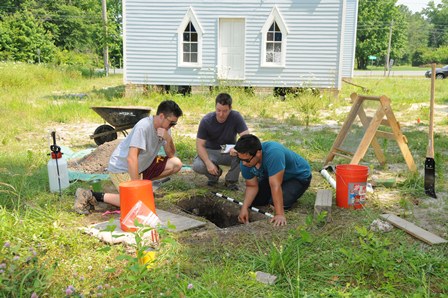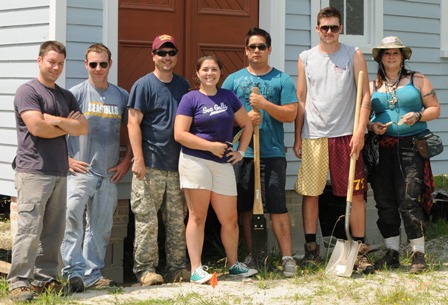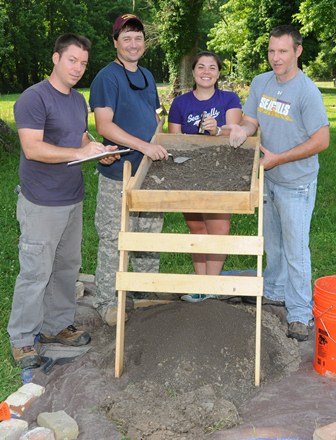Boroughs Leads SU Archaeology Team at Dorchester County Dig
 |
| From left: Colby Kish, Dr. Jason Boroughs and Mike Le. |
SALISBURY, MD---When the school that would become the Stanley Institute accepted its first students in 1865 on a plantation in Church Creek, MD, those children could not have known what the building would come to symbolize.
Moved to nearby Cambridge, MD, two years later, what was then known as Rock School — later renamed in memory of its co-founder, the Rev. Ezekiel Stanley — initially served as both church and school for the small African-American community known as Christ Rock. The two were so linked in people’s minds that when the congregation of Christ Rock Methodist Episcopal Church raised enough money to erect a separate church building, the only location that made sense was directly across the street from the school. The pair became Dorchester County landmarks.
The church and schoolhouse served as the center of the Christ Rock community until 1966, when the Stanley Institute closed. It had remained a school until 1962, continuing operation for four years after that as a community hall. A non-profit group, The Friends of Stanley Institute, Inc. (FSI), was formed to oversee the property, which was named to the National Register of Historic Places in 1975. Following the last services at Christ Rock Church, that building too was turned over to FSI, as well. In recent years, the Friends began considering options for renovating the church in hopes of preserving it for future generations.
“A lot of people tear down their history instead of trying to restore it,” said Herschel Johnson, president of the Friends. “Our objective is to rebuild.”
But to what era? Though the church building was constructed in 1875, additions were made in 1889 and 1911. Locating a painting of the church and its grounds as they appeared in 1931, the Friends made that their target. The church, however, was not the only structure in the picture. A fellowship hall, demolished in the 1950s, stood near the building. If the group was going to meet its goal of authentic recreation, it was going to need some help locating the hall’s actual footprint.
Enter Dr. Jason Boroughs.
 |
| From left: Dr. Jason Boroughs, Shannon Gallagher, John Dysart, Holly Baldwin, Mike le, Colby Kish and Daniella Bramble. |
A visiting assistant professor in Salisbury University’s History Department, Boroughs met with colleagues from the University System of Maryland at an archaeological dig at “The Hill,” a prominent African-American community in nearby Easton, MD. It was there that he learned the Friends had put out a request for proposals for an archaeology team to assist with the Christ Rock Church project.
Seizing the opportunity to give his students hands-on experience in how archaeology can be put to practical use, he outbid two commercial firms, offering to conduct the dig for free. From late May through late June, seven students joined him in what became SU’s first archaeological field school since 2002. Boroughs said his team was happy to be working on a project that meant so much to many who still reside in the community.
“A lot of the people who live here have deep roots,” he said. “Their heritage in the area, in some cases, goes back to emancipation or further. It’s pretty exciting.”
After four weeks, Boroughs and his students not only had determined the probable footprint of the fellowship hall; they also had uncovered more than 4,000 artifacts including marbles and small toys, 19th- and 20th-century coins, and decades-old soda bottles that likely were the remnants of community socials and church picnics.
“In nearly every hole they dug, they found something,” said Johnson.
Many of these items will be placed inside the rebuilt hall, which is slated to include a small museum focusing on the neighborhood’s history, he said. Relics from the schoolhouse, stored away for many years, also will be on display.
 |
| From left: Dr. Jason Boroughs, John Dysart, Holly Baldwin and Shannon Gallagher. |
While the exterior of the reconstructed hall is expected to appear as it did in the early ’30s, the inside will have modern amenities including heating, air conditioning and bathrooms. This will allow the church to once again serve the community, hosting weddings and other special events, Johnson said.
Once renovations are complete — Johnson anticipates that will be in early 2015 — the Friends will be able to double their historical tour offerings to include both the school and the church. Johnson hopes that will help draw more visitors interested in learning about Dorchester’s African-American heritage.
“People visiting Dorchester County want to see something relating to Harriet Tubman,” he said.
With that in mind, it doesn’t hurt that the buildings are located near the one-time home of Dorchester native Tubman’s husband, John. Nor that the future site of Harriet Tubman Underground Railroad State Park, scheduled to open in January 2015, is located fewer than nine miles away. Nor that the road on which the school and church sit recently became part of the Federal Highway Administration-recognized Harriet Tubman Underground Railroad Byway.
Now that the physical portion of the archaeological study has been completed, Boroughs plans to analyze the findings and compile a report for the Friends, which he also will submit to the Maryland Historical Trust.
“The students had a great experience, and hopefully our findings will help the Friends of the Stanley Institute accomplish its goals,” he said. “This was a win-win for everyone.”
For more information call 410-543-6030 or visit the SU Web site at www.salisbury.edu.
